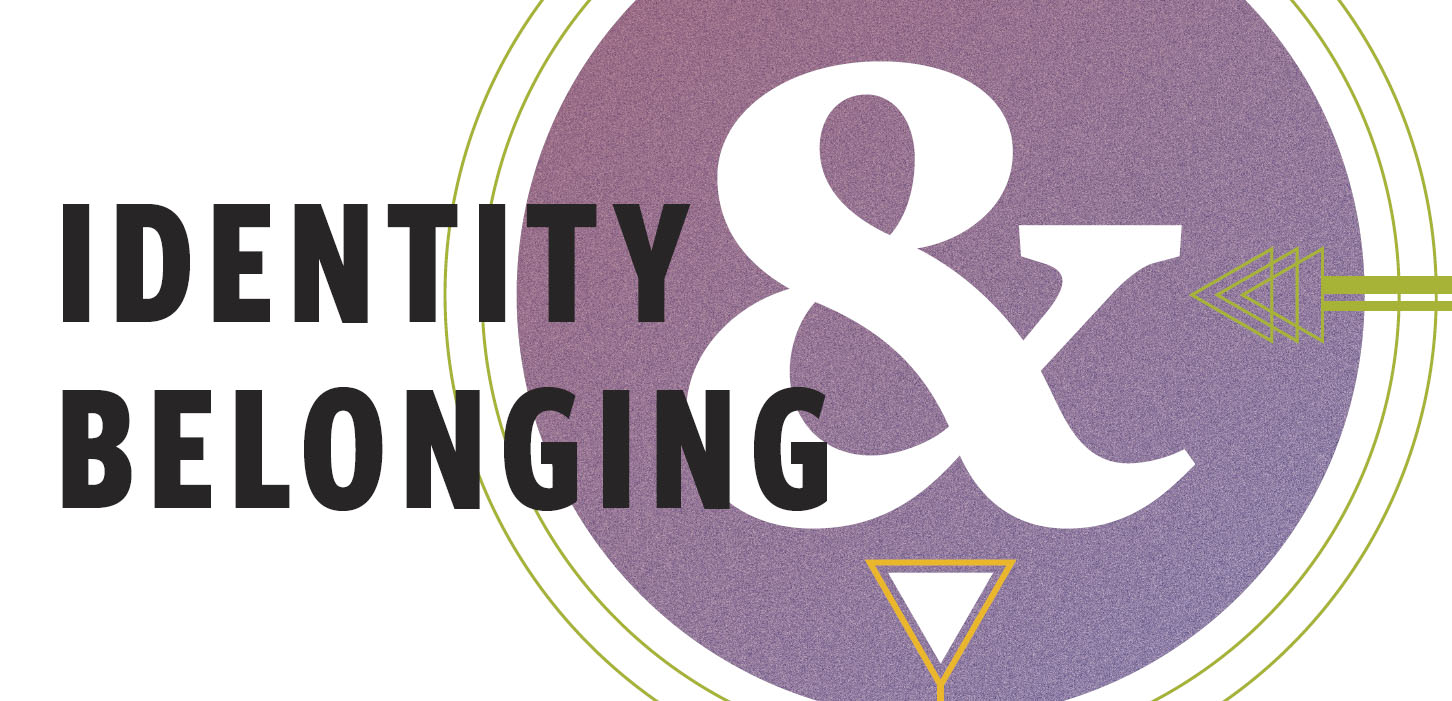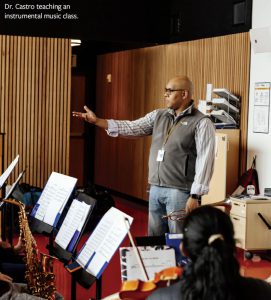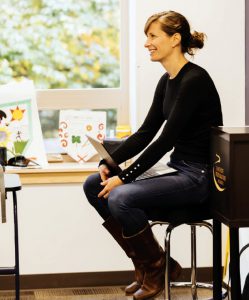
By Ed Castro and Bess McKinney, EICL Co-Coordinator
The activist Grace Lee Boggs said, “in the middle of a catastrophe, in the middle of disaster, people—particularly people who have already suffered—see an opportunity to evolve to another stage of humanity.” The 2020-2021 school year was a year of drastic change and shift, of the waking up of many to systemic inequities and racism and the harm they have caused, of pain, sadness, loss and anger. And, if we can take inspiration from Boggs, we are ready and excited to create a fuller and deeper sense of who we are and how we are each critically connected to one another. Building those critical connections requires that we recognize all of who each of us is and that we value and respect every one of us in the EPS community. It requires dedication to the fullness of identity and belonging.
Ultimately, we recognize that identity and belonging—two concepts that can, sometimes, seem in conflict, are both at the core of our work as Equity, Inclusion, and Compassionate Leadership (EICL) Coordinators.
 Modeling an Identity and Belonging Discussion
Modeling an Identity and Belonging Discussion
In our work, we often model identity and belonging discussions, practicing vulnerability, honesty, and acceptance. We bring different strengths, skills, and identities to our role as EICL Co-Coordinators. Indeed, in our work together, we aim to model what identity development and belonging can be—embracing who we are and how we complement each other. We want to take this opportunity to model that work here, to talk about how we each feel we belong and identify, and how those parts of belonging and identity fit into the larger model of our work.
ABOUT IDENTITY
Supporting teenagers’ evolving and growing understanding of their identities is central to our work with students at Eastside Prep. During our teenage years, our identity development ramps up and becomes central to our lives. And it is thus imperative that we are in communities that embrace all of who we are. In order for our work to make EPS as equitable, inclusive, and compassionate a community as it can be, we must first support all students’ identity development and help them embrace all of who they are. We must continue to build a community where all—students, alumni, families, faculty, and staff—feel that they can be fully and authentically themselves, no matter who they are, and feel that all of who they are belongs at EPS. To build this community, we must recognize and be dedicated to addressing and finding solutions for the marginalization that many community members feel because facets of their identities are those that are traditionally marginalized or underrepresented in independent schools.
Our work over the past three years to support identity development has included building up student clubs that are designed around celebration of identity, sending students to national and regional diversity conferences, hosting speakers who elevate and highlight the voices of those who are often underrepresented, and supporting teachers to do the same in their classrooms.
Ed Castro on Identity
When I was first setting up my social media accounts, I was stumped by my title. At first I thought, I should just use what’s on my business card (remember business cards?). The only problem was which one should I use. At the time, I was a freelance trumpeter with about 498 cards from Vistaprint and a music teacher at an independent private school.
But I can’t just be a trumpeter, I want to stand out as more than an instrumentalist. I am a musician who plays the trumpet. Right, so don’t use “trumpeter;” go with “musician.” Now for the other business card. I could go with “teacher” or “instructor”… time to pull out the thesaurus…EDUCATOR in big bold letters was the first word I saw. So I went with “teacher” for a while (probably because I had a narrow view of what I did at the time) however I recently changed it to “educator.” (And I like that decision.)
I had another problem…which comes first. Am I a musician who educates or an educator who is a musician? The answer to this part of my online identity was very similar to my own struggle with personal and cultural identity. My parents are from the Dominican Republic, so I am Dominican. When I’m with my mom, or brother, or any of my aunts, uncles, or cousins (lots of cousins), I am Dominican. But I was born in the United States, in the Bronx to be exact. So I’m American! I am both: 100% American and 100% Dominican. So I’m 200%!
Eventually, I settled with “musician” first, because I feel that is the seed for all that I do in a professional capacity. I can’t teach music unless I am a musician. I certainly can’t perform music on the trumpet without being a musician first. At least that’s how I feel. But the truth (like my personal and cultural identity issue) is that I can do both and am both at the same time. I can’t divorce one from the other because “that’s who I am.”
Bess McKinney on Identity
Like Dr. Castro, like all of us, I am many things. I am a mother, a wife. I am a runner, a baker, a nerd. I am a white, straight, monolingual English-speaking woman. I am a daughter and an only child. I am a feminist. I work daily to be an anti-racist. And, even at 41, my understanding of all of those facets of my identity are still evolving. When I was a high school student and a fervent feminist, I didn’t think about the fact that the new feminism club I’d founded was scheduled to meet the very same night that the students of color club was meeting. My understanding of feminism at fifteen did not, sadly, include an intersectional lens or an awareness of my own white privilege. But creating space for our identities to evolve, for each of us to grow, is essential. All of who we are, all facets of our identity, even if they are those that are assigned to us by the outside world, must be inhabited and fully understood for us to be fully who we can be.
 This past year, in the midst of the pandemic and critical national conversations about race and racism, we, too, had to recognize and take action to fully support students who were particularly impacted, because of who they are, by the events happening outside of the walls of EPS. We hosted podcast conversations about the Black Lives Matter movement from the perspective of EPS students of color. Students and faculty had a chance to discuss and explore the multifaceted world of the Latine community at EPS and beyond, through music and podcasts for Hispanic Heritage Month. We hosted open community discussions in response to the killings in Atlanta this spring and the rising hate and violence targeting communities of Asian descent. Together with Forest Ridge and Charles Wright, we organized an interschool affinity group meetup for students to have time to connect with others who share common identities. And we welcomed guest speakers who helped our understanding of identity and the work done in particular communities all around us. We examined how our intersecting identities shape our perspectives; how we can talk about race; and cultural competency as a journey and not a destination.
This past year, in the midst of the pandemic and critical national conversations about race and racism, we, too, had to recognize and take action to fully support students who were particularly impacted, because of who they are, by the events happening outside of the walls of EPS. We hosted podcast conversations about the Black Lives Matter movement from the perspective of EPS students of color. Students and faculty had a chance to discuss and explore the multifaceted world of the Latine community at EPS and beyond, through music and podcasts for Hispanic Heritage Month. We hosted open community discussions in response to the killings in Atlanta this spring and the rising hate and violence targeting communities of Asian descent. Together with Forest Ridge and Charles Wright, we organized an interschool affinity group meetup for students to have time to connect with others who share common identities. And we welcomed guest speakers who helped our understanding of identity and the work done in particular communities all around us. We examined how our intersecting identities shape our perspectives; how we can talk about race; and cultural competency as a journey and not a destination.
As we look forward to 2021-2022, we are excited about the opportunity to build even more support for students in all of who they are—more student organizations that support identity discussions and development, more guest speakers who raise up thorny questions and important conversations about who we are and how we see ourselves, and more learning for all of us on campus about how to build identity development into our classrooms.
BELONGING
Belonging is intrinsically connected to identity development—but it moves beyond ourselves to others. And while belonging is not in our job titles, it is the ultimate goal of equity, inclusion, and compassionate leadership. When we feel we belong, we feel our voice is heard and we can, in turn, speak with more confidence, more insight, more compassion for others. Indeed, “[b]elonging has long been recognized as an innate human need and an important driver of physical and psychological well-being” (Lewis, Stout, Pollock, Finkelstein, & Ito, 2016). While all of us at EPS are dedicated to creating a sense of belonging for all members of our community, as EICL Co-Coordinators we are particularly committed to building a sense of belonging for all—in our curriculum, in our teaching practices, in our student and community gatherings, in our systems, and in our communication. This proactive work must not only be responsive to and lift up the strengths, needs, and experiences of all in our community, but must also lead to a greater understanding of the world around us and our place in it.
Bess McKinney on Belonging
I moved around a lot as a kid—born in Vermont, then to Florida, Maine, Florida again, Connecticut, Rhode Island. I was jealous of those kids who stayed in one house all their lives. And jealous, too, of the sense of belonging that could come from truly knowing and being from a place.
It’s likely no coincidence, then, that once I moved to the Seattle region thirteen years ago, I didn’t look back. I made this my place. And yet, as we all know, belonging is not so simple. I still drive like an East Coaster (and am that driver who is honking at folks at a four-way stop to just “go, already!).”
And I still wonder if it’s me, or the Pacific Northwest culture that leaves me feeling lonely in the depth of cold, rainy January. We can claim a place, we can do all we can to put our roots down, and we can still feel that sinking feeling of homesickness sometimes. I’ve claimed EPS, too, and feel I belong. But, and this is what makes our EICL work so complicated, then there are times when I feel misunderstood, misaligned, and unseen. It is human to feel that, of course. It makes connection that much sweeter. But our work is to make that feeling of rootedness ring true for all of us at EPS.
Ed Castro on Belonging
Belonging can be tricky when you are a transplant. Even after fifteen-plus years in the Pacific Northwest, I still feel like I’m here on an extended visit. The reality is that I don’t think I’ll move back to the East Coast any time soon, if ever. However, being in Washington and also being a New Yorker are definitely at odds with one another in me. Sometimes I think perhaps more hiking will help me come around on this mindset. If I do that, I may need to go to REI and buy several flannel shirts, some wool socks, and even break in another pair of Birkenstocks as I grill a salmon after tasting some of Walla Walla’s best wines. Belonging is tricky. However complicated belonging may be for some of us, it is less complicated in a macro sense when working at a school like EPS. If you are looking for connections, some are built into the fabric of the school year. Trips, shared meals, after-school activities, middle band programing…you name it, the opportunities are available, and the people are nice.
Belonging at EPS for me, happens in micro-instances. One example is when my colleagues forget how long I’ve been at the school and start talking about events that happened before I got to EPS. A gentle reminder of my tenure at school is all it takes to recalibrate that moment. I will admit, it does feel good to be thought of as “being here” for longer than I have been.
The other form of micro-acceptance happens with students. I use music-related conversations to connect with students and I am often tickled when students share their musical discoveries with me and broaden my palette of sounds to explore. If I add up all of those single-serving moments, they add up to a feeling of belonging where I am. Who knows…if I use all of those moments and start birding, after paddleboarding in the Puget Sound during the one week of summer we get here…I might feel less like a transplant and more like… And I’m still from the Bronx. And I belong here.
 Every time teachers expand their curriculum to include more diverse voices in the classroom, more students feel this sense of belonging. Every time we have an assembly or Advisory activity that allows students to talk about who they are and how they have not felt seen, we expand belonging. This past year we grew that sense of belonging on campus through a community conversation about how the pandemic had affected each of us and each of us differently; in musical playlists honoring Pride and Indigenous People’s Day (these playlists can be found in the Fine & Performing Arts YouTube channel); in our first-ever student-organized Culture Night. In 2021-2022, we look forward to continuing and expanding these events and conversations
Every time teachers expand their curriculum to include more diverse voices in the classroom, more students feel this sense of belonging. Every time we have an assembly or Advisory activity that allows students to talk about who they are and how they have not felt seen, we expand belonging. This past year we grew that sense of belonging on campus through a community conversation about how the pandemic had affected each of us and each of us differently; in musical playlists honoring Pride and Indigenous People’s Day (these playlists can be found in the Fine & Performing Arts YouTube channel); in our first-ever student-organized Culture Night. In 2021-2022, we look forward to continuing and expanding these events and conversations
When he was a junior in high school, seventeen-year-old star athlete George turned to his friend and told him, “I want to touch the world.” Like most of us at seventeen, he wanted to reach out, to see and be seen, to live. Twenty-nine years later, George Floyd was murdered, and his murder led to another reckoning in this country with our pervasive systemic racism.
We tell this story not to raise, again, the horror and hurt of Floyd’s murder. Rather to recognize that our identities are complicated and multifaceted, that we all have desires and dreams, sides to ourselves that can go hidden or that can, in the best learning communities, be fostered and embraced. This year, at EPS we will continue to build the skills and connections that allow all students to feel truly seen and valued for who they each are.
